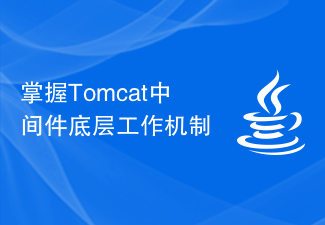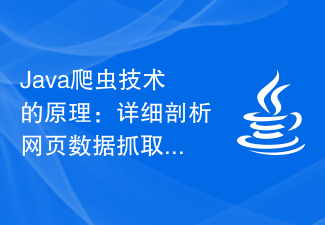 Backend Development
Backend Development PHP Tutorial
PHP Tutorial The implementation principle of PHP anti-shake technology and its application in projects
The implementation principle of PHP anti-shake technology and its application in projects
The implementation principle of PHP anti-shake technology and its application in projects
Anti-shake technology (Debounce) is a technology commonly used in front-end development. After an event is triggered, the corresponding operation is delayed until the event stops triggering for a certain period of time before it is actually executed. This technology is often used to reduce the performance impact of frequently triggered events and improve user experience. Anti-shake technology can also be implemented in PHP to handle certain frequently triggered operations, such as real-time queries in the search box.
Implementation principle:
The principle of implementing anti-shake technology in PHP is similar to that of the front end. By setting a timer, wait for a certain period of time after the event is triggered before performing the corresponding operation. If the event is triggered again during the waiting time, the timer is reset and timing is restarted until the event stops triggering and the corresponding operation is performed after the waiting time is reached.
Below we use a specific example to illustrate the implementation of anti-shake technology in PHP.
class Debounce
{
private $timer;
private $delay;
public function __construct($delay = 500)
{
$this->delay = $delay;
}
public function debounce($callback)
{
if ($this->timer) {
clearTimeout($this->timer);
}
$this->timer = setTimeout($callback, $this->delay);
}
}
// 示例使用
$searchFunction = function() {
// 执行搜索操作
}
$debounce = new Debounce();
$debounce->debounce($searchFunction);In the above example, we created a Debounce class, and the constructor receives a delay time parameter, which defaults to 500 milliseconds. The debounce method in the class is used to perform anti-shake operations, passing in a callback function as a parameter. In the debounce method, we first determine whether a timer exists. If it exists, clear the previous timer, and then reset a new timer with the delay time being the set delay time. Through such operation, the anti-shake effect can be achieved.
Application in actual projects:
In actual projects, anti-shake technology is suitable for some operations that require frequent triggering, such as real-time queries in the search box. When users enter content in the search box, if each input triggers a search operation immediately, a large number of requests will be sent to the backend, increasing the pressure on the server, and making the web page unsmooth. This problem can be avoided by using anti-shake technology, which only triggers the actual search operation after the user stops typing for a period of time.
The following is an example of using anti-shake technology in a PHP project:
function search($keyword)
{
// 执行搜索操作
}
if (isset($_GET['keyword'])) {
$keyword = $_GET['keyword'];
// 创建一个防抖实例,设置延迟时间为 1000 毫秒
$debounce = new Debounce(1000);
// 将搜索函数作为回调函数传入防抖实例
$debounce->debounce(function() use ($keyword) {
search($keyword);
});
}In the above example, when the user enters content in the search box, the entered key will be sent through a GET request. Words are passed to the backend script. In the back-end script, we create an anti-shake instance and set the delay time to 1000 milliseconds. Then pass the search function as a callback function into the debounce method of the anti-shake instance. In this way, when the user inputs, the search operation is actually triggered only after 1000 milliseconds of stopping input, effectively reducing the frequency of requests.
Summary:
The implementation principle of anti-shake technology in PHP is similar to that of the front end. By setting a timer to delay execution of operations, performance problems caused by frequent triggering events can be effectively reduced. In actual projects, anti-shake technology is suitable for some operations that require frequent triggering, such as real-time queries in the search box. By using anti-shake technology, the user experience can be improved and the pressure on the server can be reduced. In PHP, we can implement anti-shake operations by creating an anti-shake class and perform corresponding operations through callback functions.
The above is the detailed content of The implementation principle of PHP anti-shake technology and its application in projects. For more information, please follow other related articles on the PHP Chinese website!
 深入了解Kafka消息队列的底层实现机制Feb 01, 2024 am 08:15 AM
深入了解Kafka消息队列的底层实现机制Feb 01, 2024 am 08:15 AMKafka消息队列的底层实现原理概述Kafka是一个分布式、可扩展的消息队列系统,它可以处理大量的数据,并且具有很高的吞吐量和低延迟。Kafka最初是由LinkedIn开发的,现在是Apache软件基金会的一个顶级项目。架构Kafka是一个分布式系统,由多个服务器组成。每个服务器称为一个节点,每个节点都是一个独立的进程。节点之间通过网络连接,形成一个集群。K
 PHP核心的运行机制与实现原理详解Nov 08, 2023 pm 01:15 PM
PHP核心的运行机制与实现原理详解Nov 08, 2023 pm 01:15 PMPHP是一种流行的开源服务器端脚本语言,大量被用于Web开发。它能够处理动态数据以及控制HTML的输出,但是,如何实现这一切?那么,本文将会介绍PHP的核心运行机制和实现原理,并利用具体的代码示例,进一步说明其运行过程。PHP源码解读PHP源码是一个由C语言编写的程序,经过编译后生成可执行文件php.exe,而对于Web开发中使用的PHP,在执行时一般通过A
 PHP中的粒子群算法实现原理Jul 10, 2023 pm 11:03 PM
PHP中的粒子群算法实现原理Jul 10, 2023 pm 11:03 PMPHP中的粒子群算法实现原理粒子群算法(ParticleSwarmOptimization,PSO)是一种优化算法,常用于求解复杂的非线性问题。它通过模拟鸟群觅食行为,以寻找最优解。在PHP中,我们可以利用PSO算法快速求解问题,本文将介绍其实现原理,并给出相应的代码示例。粒子群算法基本原理粒子群算法的基本原理是通过迭代搜索找到最优解。算法中存在一群粒
 刨析swoole异步任务处理功能的实现原理Aug 05, 2023 pm 04:15 PM
刨析swoole异步任务处理功能的实现原理Aug 05, 2023 pm 04:15 PM刨析swoole异步任务处理功能的实现原理随着互联网技术的迅猛发展,各种问题的处理变得越来越复杂。在Web开发中,处理大量的请求和任务是一个常见的挑战。传统的同步阻塞方式无法满足高并发的需求,于是异步任务处理成为一种解决方案。Swoole作为PHP协程网络框架,提供了强大的异步任务处理功能,本文将以一个简单的示例来解析其实现原理。在开始之前,我们需要先确保已
 深入分析Kafka消息队列的技术原理与适用场景Feb 01, 2024 am 08:34 AM
深入分析Kafka消息队列的技术原理与适用场景Feb 01, 2024 am 08:34 AMKafka消息队列的实现原理Kafka是一个分布式发布-订阅消息系统,它可以处理大量的数据,并且具有很高的可靠性和可扩展性。Kafka的实现原理如下:1.主题和分区Kafka中的数据存储在主题(topic)中,每个主题可以分为多个分区(partition)。分区是Kafka中最小的存储单位,它是一个有序的、不可变的日志文件。生产者将数据写入主题,而消费者从
 掌握Tomcat中间件底层工作机制Dec 28, 2023 pm 05:25 PM
掌握Tomcat中间件底层工作机制Dec 28, 2023 pm 05:25 PM理解Tomcat中间件的底层实现原理,需要具体代码示例Tomcat是一个开源的、使用广泛的JavaWeb服务器和Servlet容器。它具有高度的可扩展性和灵活性,常用于部署和运行JavaWeb应用程序。为了更好地理解Tomcat中间件的底层实现原理,我们需要探究它的核心组件和运行机制。本文将通过具体的代码示例,解析Tomcat中间件的底层实现原理。Tom
 C语言中乘方运算的实现原理Feb 20, 2024 pm 09:57 PM
C语言中乘方运算的实现原理Feb 20, 2024 pm 09:57 PMC语言中乘方运算的实现原理在C语言中,乘方运算是计算一个数的n次方,即计算x^n的结果。虽然C语言本身没有提供直接的乘方运算符,但可以通过循环或递归等方法来实现乘方运算。一、循环法实现乘方运算循环法是一种比较常用的实现乘方运算的方法,其基本思想是通过多次循环累乘来计算结果。示例代码如下:#includedoublepow
 Java爬虫技术的原理:详细剖析网页数据抓取过程Jan 09, 2024 pm 02:46 PM
Java爬虫技术的原理:详细剖析网页数据抓取过程Jan 09, 2024 pm 02:46 PM深入解析Java爬虫技术:网页数据抓取的实现原理引言:随着互联网的快速发展和信息爆炸式增长,大量的数据被存储在各种网页上。这些网页数据对于我们进行信息提取、数据分析和业务发展非常重要。而Java爬虫技术则是一种常用的网页数据抓取方式。本文将深入解析Java爬虫技术的实现原理,并提供具体的代码示例。一、什么是爬虫技术爬虫技术(WebCrawling)又称为网


Hot AI Tools

Undresser.AI Undress
AI-powered app for creating realistic nude photos

AI Clothes Remover
Online AI tool for removing clothes from photos.

Undress AI Tool
Undress images for free

Clothoff.io
AI clothes remover

AI Hentai Generator
Generate AI Hentai for free.

Hot Article

Hot Tools

VSCode Windows 64-bit Download
A free and powerful IDE editor launched by Microsoft

SublimeText3 Mac version
God-level code editing software (SublimeText3)

Zend Studio 13.0.1
Powerful PHP integrated development environment

mPDF
mPDF is a PHP library that can generate PDF files from UTF-8 encoded HTML. The original author, Ian Back, wrote mPDF to output PDF files "on the fly" from his website and handle different languages. It is slower than original scripts like HTML2FPDF and produces larger files when using Unicode fonts, but supports CSS styles etc. and has a lot of enhancements. Supports almost all languages, including RTL (Arabic and Hebrew) and CJK (Chinese, Japanese and Korean). Supports nested block-level elements (such as P, DIV),

SAP NetWeaver Server Adapter for Eclipse
Integrate Eclipse with SAP NetWeaver application server.





